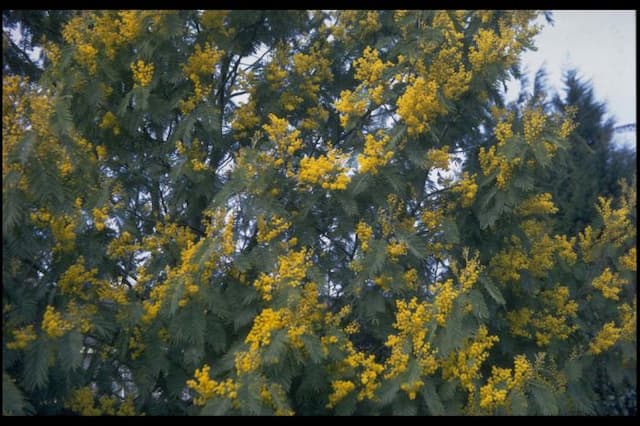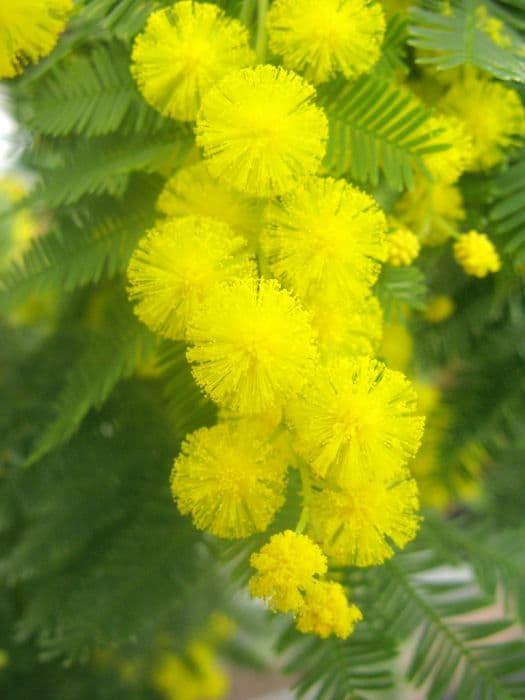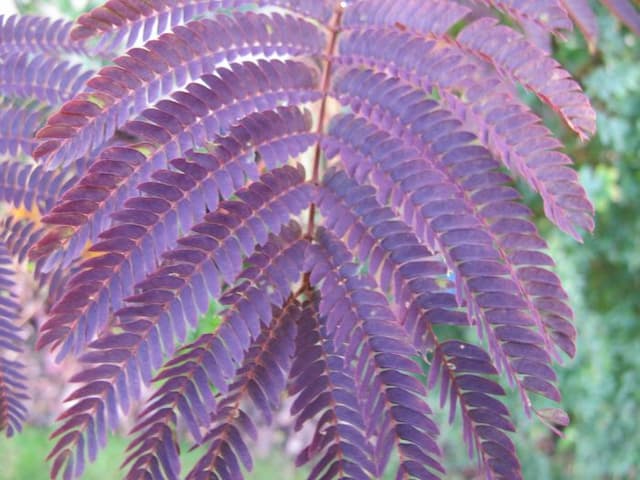Lupine Lupinus 'The Chatelaine' (Band of Nobles Series)

ABOUT
Lupinus 'The Chatelaine', also known as The Chatelaine Lupine, is a captivating perennial known for its ornamental features. This plant boasts tall spires adorned with densely packed, sweetly scented flowers that have a graceful bicolor appearance—generally a soft pink with a white standard, which is the upright petal in the flower's center that can sometimes display a gentle flush of another color. The flowers are arranged in a whorled pattern around the spike, contributing to a striking vertical element in the garden landscape. The foliage of The Chatelaine Lupine is palmately compound, meaning the leaves radiate out from a central point like the fingers of a hand. Each leaflet is narrow with a pointed tip, adding a delicate texture to the plant that contrasts beautifully with the robust flower spikes. The leaves are a rich green color that further highlights the pastel hues of the blooms. This plant, with its impressive flower display and attractive foliage, creates a dramatic visual impact. It's particularly popular for its period of bloom in late spring to early summer, when the garden is transformed by the vertical interest and romantic color palette of The Chatelaine Lupine.
About this plant
 Names
NamesFamily
Fabaceae
Synonyms
The Chatelaine Lupine, Band of Nobles Lupin
Common names
Lupinus 'The Chatelaine'
 Toxicity
ToxicityTo humans
Lupine, including the variety known as 'The Chatelaine', contains toxic alkaloids such as lupanine, which can cause poisoning in humans if ingested. Symptoms of lupine poisoning may include dizziness, difficulty breathing, fast heartbeat, convulsions, and potentially fatal respiratory depression. The most severe reactions typically result from the consumption of the seeds. It is important to avoid ingesting any part of the plant and to keep it out of reach of children who might mistakenly eat the seeds or other plant parts.
To pets
Lupine, including the cultivar 'The Chatelaine', is toxic to pets as well. It contains alkaloids that can cause symptoms such as vomiting, diarrhea, rapid heart rate, tremors, and convulsions if ingested. In severe cases, it can lead to respiratory failure and death. Care should be taken to prevent pets from accessing or consuming the plant to avoid the risk of poisoning.
 Characteristics
CharacteristicsLife cycle
Perennials
Foliage type
Deciduous
Color of leaves
Green
Flower color
Pink
Height
3 feet (91 cm)
Spread
2 feet (60 cm)
Plant type
Herb
Hardiness zones
4
Native area
Mediterranean
Benefits
 General Benefits
General Benefits- Attracts Pollinators: Lupinus 'The Chatelaine' is known to attract bees, butterflies, and other beneficial insects, which are important for the pollination of many plants.
- Ornamental Value: With its tall spikes of bi-color pink and white flowers, this plant adds visual interest and beauty to gardens and landscapes.
- Drought Resistance: Once established, lupines are quite drought-tolerant, making them suitable for gardens in drier climates or for water-wise landscaping.
- Nitrogen Fixation: As a member of the legume family, lupines have the ability to fix nitrogen in the soil, which can improve soil fertility and benefit surrounding plants.
- Deer Resistance: Lupinus 'The Chatelaine' is not a favorite of deer, so it's less likely to be damaged in areas where deer browse.
- Perennial Growth: As a perennial, this plant will return year after year, providing long-term presence in a garden bed or border.
- Vertical Interest: The vertical growth habit of the flower spikes makes it an excellent choice for adding height and structure to planting designs.
 Medical Properties
Medical PropertiesThis plant is not used for medical purposes.
 Air-purifying Qualities
Air-purifying QualitiesThis plant is not specifically known for air purifying qualities.
 Other Uses
Other Uses- As a natural dye: The flowers of lupine can be used to produce a natural dye for fabric or wool, often yielding shades of blue and purple depending on the mordant used.
- In biodegradable pots: The fast-degrading nature of lupine's roots makes them a candidate for creating biodegradable seedling pots that can be planted directly into the soil.
- As cover crops: Lupines can be planted to prevent soil erosion, improve soil structure, and increase nitrogen levels due to their nitrogen-fixing abilities.
- Soil remediation: Lupine plants have been considered for phytoremediation, to remove heavy metals and other pollutants from the soil.
- In butterfly gardens: Being attractive to butterflies and pollinators, lupines can play a role in supporting local biodiversity within a butterfly or wildlife garden.
- As an educational tool: Lupines can be used in schools or educational programs to teach about plant biology, especially regarding nitrogen fixation and symbiotic relationships with soil bacteria.
- In companion planting: Lupines are sometimes used in companion planting schemes to benefit neighboring plants by enriching the soil with nitrogen.
- As green manure: When chopped and turned into the soil, lupines act as green manure to fertilize the soil for subsequent plantings.
- In crop rotation systems: Their nitrogen-fixing properties make lupines a good choice for inclusion in crop rotation systems to maintain soil health.
- For wildlife forage: In rural and naturalized areas, lupine can provide forage for wild animals such as deer and other herbivores.
Interesting Facts
 Feng Shui
Feng ShuiThe Lupine is not used in Feng Shui practice.
 Zodiac Sign Compitability
Zodiac Sign CompitabilityThe Lupine is not used in astrology practice.
 Plant Symbolism
Plant Symbolism- Voracity: Lupines often symbolize an appetite for life and a desire to consume experiences due to their vigorous growth habits.
- Innovation: The hybrid nature of 'The Chatelaine' suggests creativity and the willingness to blend ideas to produce something new and beautiful.
- Protection: The lupine's association with wolves (from the Latin "lupus") implies guardianship and the nurturing of family and community.
- Admiration: 'The Chatelaine', as part of the Band of Nobles Series, conveys a sense of honor and respect, often reserved for individuals who demonstrate qualities of leadership and nobility.
 Water
WaterThe Lupine, commonly known as 'The Chatelaine', should be watered deeply and thoroughly to ensure water reaches the root zone, about once a week during its active growing season in spring and summer. It's vital to allow the soil to dry out slightly between waterings, but not completely, which helps prevent root rot. Depending on the climate and soil drainage, you may need to adjust watering frequency. On average, providing roughly one to two gallons of water per week should suffice, though this can vary depending on weather conditions.
 Light
LightLupines, such as 'The Chatelaine', thrive in full sun to partial shade. They perform their best when receiving at least 6 hours of sunlight a day, so placing them in a spot where they can soak up the morning sun with some afternoon shade is ideal. Avoid deep shade as this can hinder flowering and promote fungal growth.
 Temperature
TemperatureLupines like 'The Chatelaine' prefer moderate temperatures, thriving best when daytime temperatures are between 60 to 75 degrees Fahrenheit. They can tolerate a minimum temperature down to freezing (32 degrees Fahrenheit) and a maximum temperature of about 85 degrees Fahrenheit, but prolonged exposure outside this range can stress the plant.
 Pruning
PruningPrune the Lupine, 'The Chatelaine', to encourage bushy growth and to remove spent floral spikes to potentially stimulate a second bloom. Prune after the first flowering, usually in midsummer, and deadhead as necessary. Cutting back the plant by about one third can also help revitalize leggy specimens.
 Cleaning
CleaningAs needed
 Soil
SoilLupine 'The Chatelaine' thrives in light, well-draining soil with a slightly acidic to neutral pH range of 6.0 to 7.0. A high-quality soil mix that includes compost, peat, and sandy or gritty materials to improve drainage is ideal. Regular feeding with a balanced fertilizer will support robust growth.
 Repotting
RepottingLupines, such as 'The Chatelaine', are typically perennial plants and do not require frequent repotting. They are often grown as annuals; hence repotting is usually not necessary. If planted in containers, repotting every couple of years may be needed to refresh the soil.
 Humidity & Misting
Humidity & MistingLupine 'The Chatelaine' prefers moderate humidity levels but is relatively adaptable to a range of conditions. They do not require overly humid environments, making them suitable for typical outdoor garden settings.
 Suitable locations
Suitable locationsIndoor
Ensure bright light, cool temps, well-draining soil, and moderate water.
Outdoor
Plant in full sun, well-draining soil, and water regularly.
Hardiness zone
4-8 USDA
 Life cycle
Life cycleLupinus 'The Chatelaine' (also known as Lupine), belonging to the Band of Nobles Series, begins its life cycle as a seed that germinates in early spring once the soil has warmed and danger of frost has passed. After sprouting, the seedling grows rapidly, sporting its characteristic palmate leaves, and strengthens its root system. The plant then enters a vigorous vegetative stage, during which it develops a sturdy stem and foliage. By late spring to early summer, the Lupine progresses to the flowering stage, where it produces tall, colorful spires of pea-like flowers that attract pollinators. Following pollination, seeds develop in pods and, once mature, the pods crack open to disperse seeds for the next generation. The lupine is a perennial, so after seeding, it may die back in fall or winter, depending on climate, to re-emerge from its rootstock the following spring.
 Propogation
PropogationPropogation time
Spring-Early Summer
Lupine 'The Chatelaine', a member of the Band of Nobles Series, can be propagated through a popular method which involves sowing seeds directly. The best time to propagate lupines by seed is in spring. Seeds should be sown in a light, well-draining soil mix, with a light covering of soil. Prior to sowing, it's recommended to soak the seeds in lukewarm water for a period of 24 hours to soften the seed coat and promote germination. Sow the seeds about 1/8 inch deep (approximately 3 millimeters) and keep the soil consistently moist but not waterlogged. Seedlings typically emerge in 14-28 days, depending on soil and weather conditions. Once the seedlings have grown strong enough to handle, they can be transplanted to their final growing position, ensuring they are spaced adequately to accommodate their mature size.









